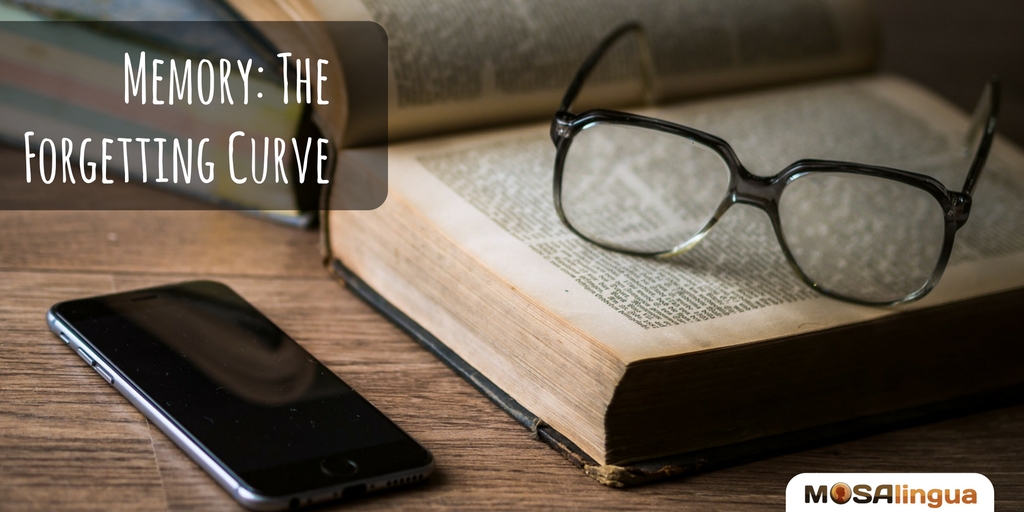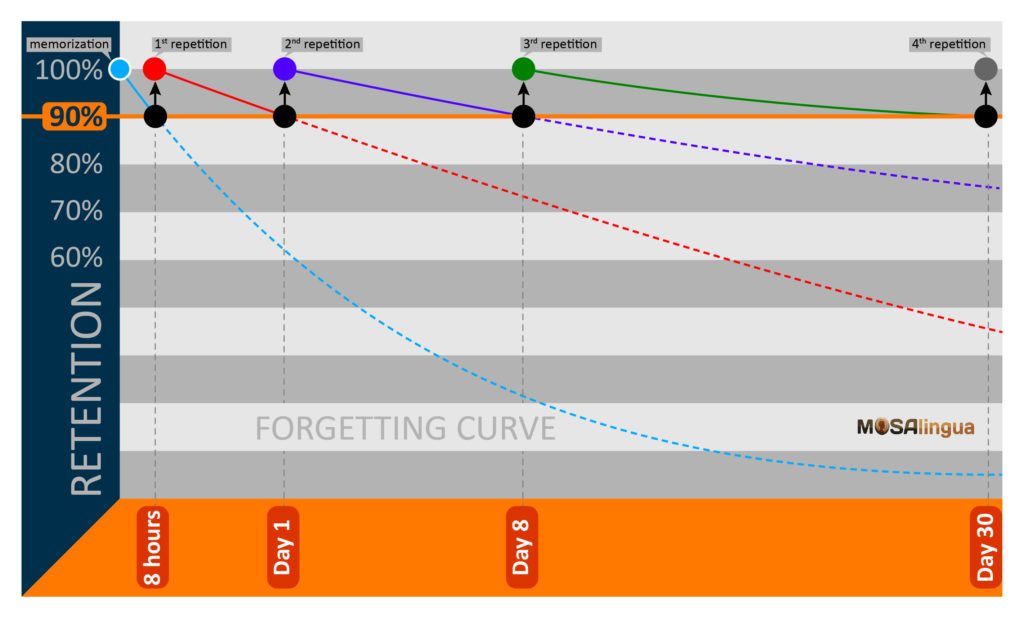When you don’t have the right approach, learning (and memorization) can seem long and tedious. And when you’re finally able to memorize the information, the game’s not over. The brain has the bothersome tendency of getting rid of any information that isn’t used regularly. Learning, and memory in general, are only as effective as the method used. As you can see from the graph below, information fed to the brain tends to be rapidly forgotten. This can happen in as little as a few hours after learning! Let’s take a look at the “Forgetting Curve,” an integral part of MosaLingua’s super effective Spaced Repetition System, and how we can use it to learn languages more quickly and efficiently.
Last Updated: 11/12/2020

MosaLingua’s Forgetting Curve
Above is a graphical representation of the “Forgetting Curve.” Take a look at the blue line: it shows just how rapidly information is forgotten after you first learn it. In as little as 8 hours, much of what you’ve learned is already slipping away. By Day 1, most people will only be able to recall about 60% of what was learned. By Day 8, retention is down to just 20%. Yikes!
Memory Strength
Of course, not everything you learn or experience is treated the same way. Some memories are stronger than others. You’ve no doubt experienced this yourself—some information just seems to stick in your brain. There are a few different reasons why this might happen. One of the most common, however, is because the memory is associated with a particularly strong emotion.
That doesn’t mean you need to be in a heightened emotional state to learn languages effectively, though! There are plenty of tips on how to memorize and learn information. As we’ve already mentioned, associating what you’re learning with an emotion is a good one. For example, to remember the word for Dog in French (chien), you could try to picture your childhood dog anytime you think of the word chien.
Another useful approach is to use a technique called the “memory palace.” This technique, used by ancient Greek philosophers, enables you to associate new information with a well-known space, like your home or school. It’s a great way to improve memory strength. (Click the link to find out more.)
Finally, your body chemistry can have a big effect on how strong your memories are. That’s why certain lifestyle and food choices can help make the difference between strong and weak memories starting out. Maintaining low stress levels, getting a good amount of sleep, and meditating are just a few ways to build stronger memories.
Ultimately though, there’s one more factor that has a big impact on how well you remember something…
Memory & Time
The Forgetting Curve above demonstrates the important role that time plays in learning and forgetting. Without intervention or an appropriate learning strategy, most learners forget 90% of what they’ve learned within the first month. In fact, it’s not unusual to have forgotten up to 30% after a few hours of studying a language
But don’t despair! With the right approach, you can ensure that the information you learn is added to your long-term memory. Here, it is far less likely to be forgotten. We’ve already mentioned the importance of building strong memories, but there’s something else that you can do to make sure you make rapid progress in your target language, and retain 100% of what you learn.
Repetition is Key
You probably noticed that the infographic above makes mention of repetitions — and each time a repetition is marked on the graph, the level of retention (memorization) goes back up to 100%.
Repetition really is the ultimate key to success. The more frequently you repeat a word or phrase that you’ve learned, the better able you’ll be to remember it later on. Research has shown that when you review vocabulary at regular intervals, it increases your retention. As time goes on, you don’t need to review words as often. In fact, this is the real meaning of the graph above: you’ll notice that the repetitions get more and more spaced out. That’s because after each repetition, the time it takes for you to forget a word gets longer and longer. Eventually, it tapers off to a flat line, and the memory is secured in your brain.
It might sound like a lot of hard work to figure out the right repetition schedule for all the different words and phrases you need to learn to speak a language. Well, you’ll be happy to know that the Spaced Repetition System is an integral part of the MosaLingua approach! This is one of the things that makes our approach so successful—along with an emphasis on language immersion, prioritizing fun activities, and focusing on vocabulary and speech before rules of grammar.
Even though we’ve known about the forgetting curve for centuries, few learning methods take it into account, including traditional language courses at school. This is one of the reasons why most language-learning methods fail to help students retain everything they’ve learned. This is a frustrating experience and can make it difficult to stay properly motivated.
How not to forget a foreign language: 3 Golden Rules [Video]
This is such an important element of learning a language that we decided to make a video of the three best ways not to forget a foreign language. The video is in English, but you can watch it with subtitles in English, French, Spanish, Portuguese, Italian or German by clicking on the ⚙ settings icon at the bottom-right. You can also slow down the video from the same menu.
Don’t forget to subscribe to our YouTube channel for more useful videos about language learning!
Armed with the knowledge of the forgetting curve, the importance of strong memories and especially that of repetition, you should have no trouble making progress in your target language. For some more great ideas, be sure to check out these articles:
- Five Simple Ways to Memorize Vocabulary
- How to Learn Vocabulary Quickly and Effectively
- Hands-On Learning: The Fun Way to Improve Your Language Skills
Related posts:
Start learning a new language today

Good news: we can help!
More good news: you can get started for free! Start your free trial now and for the next 15 days, take advantage of the most effective language learning method on the market!
Vocabulary flashcards, videos with subtitles, audiobooks, articles adapted to your level – with MosaLingua Premium (Web & Mobile), you’ll have access to all this and more. Get started right now. It’s free—and risk-free—to try!





Comments